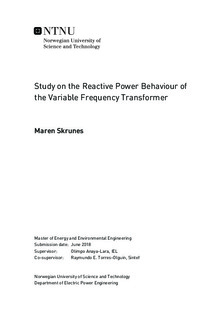Study on the Reactive Power Behaviour of the Variable Frequency Transformer
Master thesis
Permanent lenke
http://hdl.handle.net/11250/2572907Utgivelsesdato
2018Metadata
Vis full innførselSamlinger
- Institutt for elkraftteknikk [2468]
Sammendrag
The majority of the power system networks in the world today operate at a nominal frequency of either 50 or 60 Hz. Merging of adjacent power networks will expand the world's power supply system and thereby increase the possibility to utilize available power sources and deliver quality power. This Master's thesis investigates the Variable Frequency Transformer (VFT) concept, which has been proposed by General Electric as a solution for interconnecting two asynchronous networks whilst enabling controllable, bi-directional power flow between them. The mechanical design of the VFT is based on the well-known technologies of the hydro generator and the transformer. The core of the VFT is a rotary transformer, and it operates like a phase shifting transformer by adjusting the phase angle to transfer power between the two electrical networks. The principle of operation and fundamentals of the VFT are investigated with particular emphasis on understanding reactive power characteristics and requirements.
The VFT facilitates active power exchange between the two asynchronous networks and also provides a path for reactive power exchange which, however, is not fully controllable. A basic model of a 100 MW VFT interconnecting the two power networks is implemented in MATLAB/Simulink. A thorough study is conducted to understand the reactive power requirements for different operating conditions in terms of the power flow exchange between the two networks. Simulation results indicates substantial amounts of reactive power requirements in the machine during active power exchange. Two solutions are investigated to provide reactive power compensation, namely electromechanical capacitor bank and power electronic based STATCOM. Reactive power compensation by means of passive capacitor banks was able to improve system capacity and bring grid voltage to its nominal value. An active compensation by a STATCOM was investigated and a voltage regulation control scheme was suggested for implementing the STATCOM and the VFT in a combined system.
